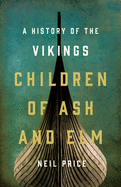
This majestic history of the medieval-era Scandinavian society that has broadly been called "the Vikings" is, in many ways, a reclamation of a people. For centuries, the popular conception of Viking-kind has come not from the records of the Scandinavians themselves but from accounts of other societies who encountered a people that the ninth-century Anglo-Saxon Chronicle called "seaborne pagans." Neil Price, the chair of archeology at Sweden's Uppsala University, points out that the term viking was, for the victims of these Norsemen's raids, something like pirate--a description of what some of them did, rather than who they all were. Children of Ash and Elm illuminates the brutal realities of Viking raids, of course, but its revelatory power comes from its focus on the culture that built and launched those ships, an industrial feat more impressive than the pillaging.
Price draws more deeply on material culture and archeological findings than he does on the famous Viking sagas, most of which date from centuries after the events they chronicle. He guides readers into Viking graves, privies, halls and stomachs; into their complex conception of the soul and their transactional religious practices; and sifts through the latest evidence for their variety of gender and sexual identities. Fascinating surprises abound: despite their barbaric rep, Viking men's fussy habit of hair combing reveals a zeal for personal hygiene, and men and women Vikings alike sometimes favored eye makeup. Price's stripping away of Viking cliché still leaves warriors worthy of the songs--they're just people now, too. --Alan Scherstuhl, freelance writer and editor

